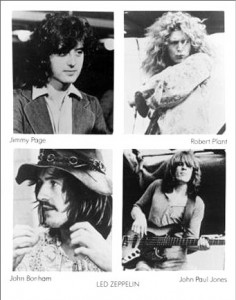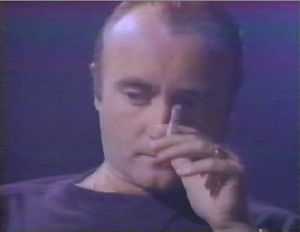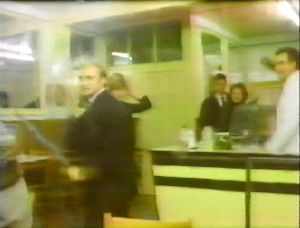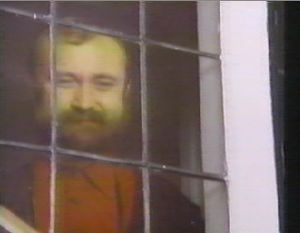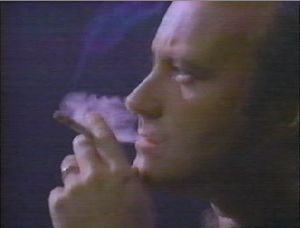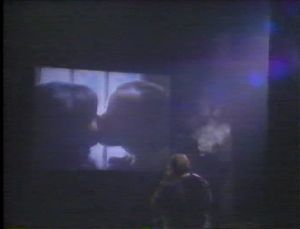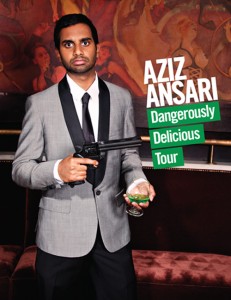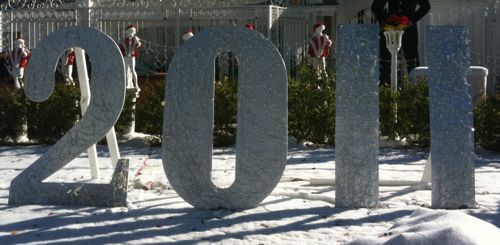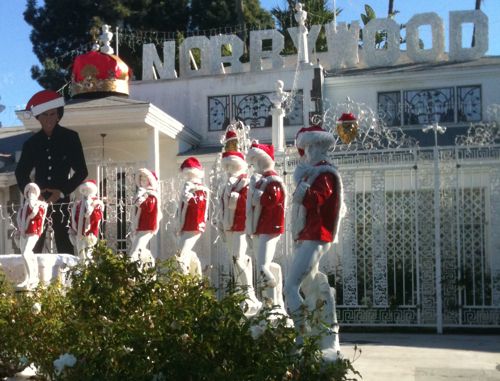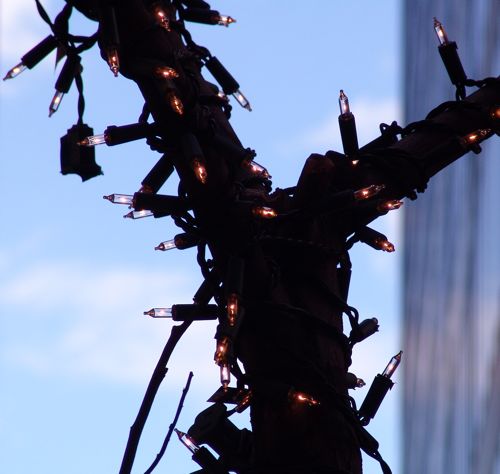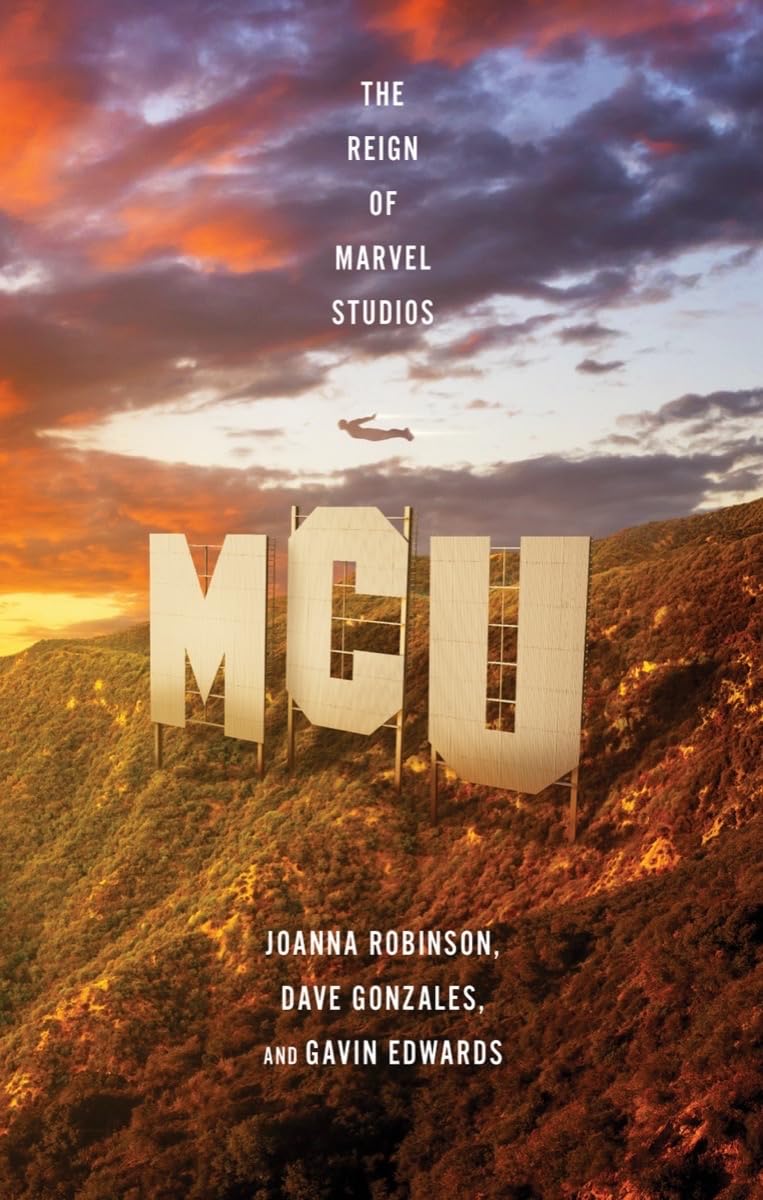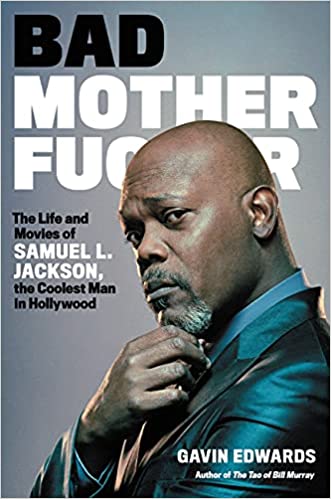1988 Countdown: Guns N’ Roses, “Paradise City”
(New to the countdown? Catch up here.)
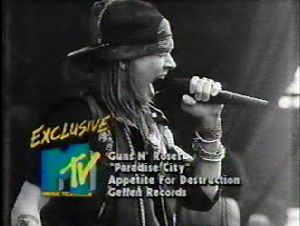 Without any explanation, Kevin Seal returns, to explain that they have room to squeeze in another bonus video from late 1988. (We haven’t had one of these in four hours, but previously “Armageddon It” and “Angel of Harlem” were added to the mix.) As Seal puts it (in a segment that must have been taped before Adam Curry showed up, and is so generic it doesn’t even mention Guns N’ Roses): “So we’re counting down the top one hundred videos of 1988, but just because it didn’t have one of these numbers arbitrarily assigned to it to give it a position, that doesn’t mean it wasn’t a great video. There were some videos that came along in ’88 that were really top-notch, but we just couldn’t get them in in time. That doesn’t make them bad–in fact, maybe it makes them better. Maybe we’ll find out about just how good they were, you know, arbitrary-number-wise, in ’89. So let’s take a look at this.” He raises one eyebrow, and then the other. If Kevin Seal were the Cheshire Cat, he would now disappear, leaving only his raised eyebrows.
Without any explanation, Kevin Seal returns, to explain that they have room to squeeze in another bonus video from late 1988. (We haven’t had one of these in four hours, but previously “Armageddon It” and “Angel of Harlem” were added to the mix.) As Seal puts it (in a segment that must have been taped before Adam Curry showed up, and is so generic it doesn’t even mention Guns N’ Roses): “So we’re counting down the top one hundred videos of 1988, but just because it didn’t have one of these numbers arbitrarily assigned to it to give it a position, that doesn’t mean it wasn’t a great video. There were some videos that came along in ’88 that were really top-notch, but we just couldn’t get them in in time. That doesn’t make them bad–in fact, maybe it makes them better. Maybe we’ll find out about just how good they were, you know, arbitrary-number-wise, in ’89. So let’s take a look at this.” He raises one eyebrow, and then the other. If Kevin Seal were the Cheshire Cat, he would now disappear, leaving only his raised eyebrows.
“This” is about ten seconds of a Bon Jovi promo. Then the stoned intern in the control room realizes he pressed the wrong button and puts on the “Paradise City” video instead.
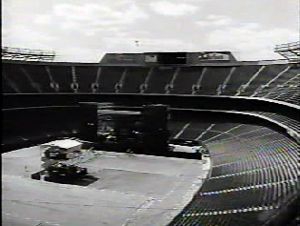 The camera pans across a football stadium (specifically, the old Giants Stadium at the Meadowlands in New Jersey) with row after row of empty seats. I hope this is a soundcheck, because otherwise Guns N’ Roses are having serious trouble selling tickets. We see their stage set up at one end of the field, a sound tower about forty yards back from the stage, and a camera crew in front of the stage. There’s a brief shot of T-shirts at the merch table, featuring the original Robert Williams cover for Appetite for Destruction and the slogan “Guns-N Roses Was Here.”
The camera pans across a football stadium (specifically, the old Giants Stadium at the Meadowlands in New Jersey) with row after row of empty seats. I hope this is a soundcheck, because otherwise Guns N’ Roses are having serious trouble selling tickets. We see their stage set up at one end of the field, a sound tower about forty yards back from the stage, and a camera crew in front of the stage. There’s a brief shot of T-shirts at the merch table, featuring the original Robert Williams cover for Appetite for Destruction and the slogan “Guns-N Roses Was Here.”
Slash, without top hat or shirt, stands at a microphone. Slash is often shirtless in this video: he’s skinny but not buff (in 1988, male musicians were not yet expected to spend time in the gym). Guitarist Izzy Stradlin laughs in the sunshine, wearing a white button-down shirt and his trademark vest. Bassist Duff McKagan, looking crazy young, sits on an equipment case, wearing a CBGBs T-shirt. Drummer Steven Adler looks around, bewildered (as usual). More quick cuts of the band and crew milling about, all in glorious black and white. Adler sits at his kit and pounds out the beat.
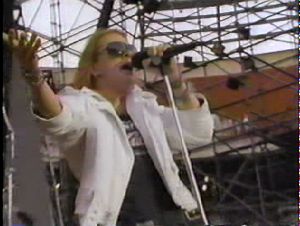 And then W. Axl Rose arrives, pulling the mike stand close to him. The video pops into color–you decide whether he’s Glinda or the Wicked Witch of the West. Axl’s wearing an obnoxious white jacket and oversized sunglasses. His left arm has a bunch of bracelets; his right arm has two watches. His red hair looks long and stringy. The band has been on the road for a while, and honestly, it doesn’t look like Axl is taking good care of himself. As Axl sings, the cameraman zooms in tight on his face so we can see just how puffy he is.
And then W. Axl Rose arrives, pulling the mike stand close to him. The video pops into color–you decide whether he’s Glinda or the Wicked Witch of the West. Axl’s wearing an obnoxious white jacket and oversized sunglasses. His left arm has a bunch of bracelets; his right arm has two watches. His red hair looks long and stringy. The band has been on the road for a while, and honestly, it doesn’t look like Axl is taking good care of himself. As Axl sings, the cameraman zooms in tight on his face so we can see just how puffy he is.
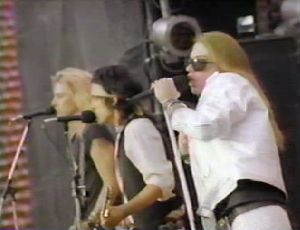 Duff, Izzy, and Axl stand in a row, harmonizing at three mike stands, with Axl swiveling his hips in that tuna-on-a-hook dance move he liked so much. We get some quick syncopated black-and-white cutaways to the band members offstage (and to another concert we’ll be seeing later in the video). As the opening chorus ends and the synthesizer kicks in, Axl raises his right arm and thrusts the microphone away from his body with his left arm. In a nifty bit of editing, the camera wheels around to show that the stadium is now full of fans.
Duff, Izzy, and Axl stand in a row, harmonizing at three mike stands, with Axl swiveling his hips in that tuna-on-a-hook dance move he liked so much. We get some quick syncopated black-and-white cutaways to the band members offstage (and to another concert we’ll be seeing later in the video). As the opening chorus ends and the synthesizer kicks in, Axl raises his right arm and thrusts the microphone away from his body with his left arm. In a nifty bit of editing, the camera wheels around to show that the stadium is now full of fans.
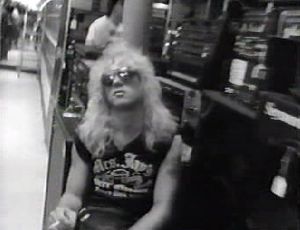 Following in the footsteps of the Magic Rat, three of the Gunners head across the Jersey state line and into New York City–specifically West 48th Street, home to Manny’s Guitar Shop. (Manny’s, like Giants Stadium, recently went out of business.) Slash holds a guitar and a pack of Marlboros. His denim vest has lots of rock buttons and a Sex Pistols patch. Duff sits down to try out a bass: he’s sporting a leather vest. Apparently Guns N’ Roses got a group discount from Izzy’s vest salesman. A seated Adler leans against a pole. He’s wearing mirrored sunglasses and appears to have fallen asleep while smoking a cigarette. The camera crew comes in for a close-up; Adler doesn’t flinch.
Following in the footsteps of the Magic Rat, three of the Gunners head across the Jersey state line and into New York City–specifically West 48th Street, home to Manny’s Guitar Shop. (Manny’s, like Giants Stadium, recently went out of business.) Slash holds a guitar and a pack of Marlboros. His denim vest has lots of rock buttons and a Sex Pistols patch. Duff sits down to try out a bass: he’s sporting a leather vest. Apparently Guns N’ Roses got a group discount from Izzy’s vest salesman. A seated Adler leans against a pole. He’s wearing mirrored sunglasses and appears to have fallen asleep while smoking a cigarette. The camera crew comes in for a close-up; Adler doesn’t flinch.
On a New York City street, Duff signs an autograph. His T-shirt declares, “And on the 8th day God created Harley-Davidson.” The synthesizer keeps cascading.
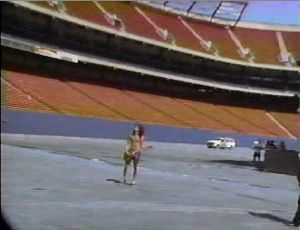 Back in Jersey: we return to Giants Stadium, the only inanimate object ever to have a song written from its perspective by Bruce Springsteen. We’ve traveled back in time: the Gunners are soundchecking again. A shirtless Slash plays guitar on the Giants Stadium blue-tarp floor, where the fans will stand. Montage: early-arriving fans run into the stadium and sit down behind an invisible line enforced by security guards. One of the things I love about this video is the director’s eye for rock-concert moments like that: they feel true to anyone who’s ever gone to a stadium show, but normally don’t make it into the glamour reel of rock videos.
Back in Jersey: we return to Giants Stadium, the only inanimate object ever to have a song written from its perspective by Bruce Springsteen. We’ve traveled back in time: the Gunners are soundchecking again. A shirtless Slash plays guitar on the Giants Stadium blue-tarp floor, where the fans will stand. Montage: early-arriving fans run into the stadium and sit down behind an invisible line enforced by security guards. One of the things I love about this video is the director’s eye for rock-concert moments like that: they feel true to anyone who’s ever gone to a stadium show, but normally don’t make it into the glamour reel of rock videos.
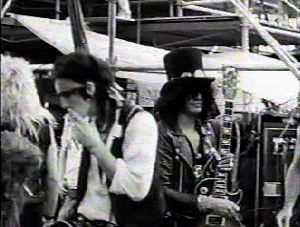 The Gunners strap on their instruments. Izzy appears to be wearing red leather pants. Back in New York City, Slash flips through a magazine sold by one of those guys selling used magazines on a blanket laid out on the sidewalk. More fans file in, and when the stadium is full, Axl reappears on the scene, wearing a peaked leather military cap and oversized sunglasses. Slash is wearing his top hat again. (When I profiled Velvet Revolver a few years ago, Scott Weiland told me Slash had been dithering about whether to wear the hat on tour; Weiland leaned on him to don it, as an essential part of his image.) The camera finds a skinny young woman in the crowd, clapping her hands while sitting on someone’s shoulders. She’s wearing a sleeveless T and a bandana: in other words, an Axl costume.
The Gunners strap on their instruments. Izzy appears to be wearing red leather pants. Back in New York City, Slash flips through a magazine sold by one of those guys selling used magazines on a blanket laid out on the sidewalk. More fans file in, and when the stadium is full, Axl reappears on the scene, wearing a peaked leather military cap and oversized sunglasses. Slash is wearing his top hat again. (When I profiled Velvet Revolver a few years ago, Scott Weiland told me Slash had been dithering about whether to wear the hat on tour; Weiland leaned on him to don it, as an essential part of his image.) The camera finds a skinny young woman in the crowd, clapping her hands while sitting on someone’s shoulders. She’s wearing a sleeveless T and a bandana: in other words, an Axl costume.
 A whistle blows. The camera whip-pans from the lighting crew sitting behind spotlights to the stage; we cut to Axl, who whips his head back and forth. (The cap is gone, but we’ll be seeing it later.) Red hair flying everywhere, he tosses away his sunglasses and grabs onto the microphone like it’s the only thing stopping him from falling off the stage. “Just an urchin living under the street,” he sings with his hair in his face. Under? Really? In a sewer, maybe? Or a cave beneath the sidewalk?
A whistle blows. The camera whip-pans from the lighting crew sitting behind spotlights to the stage; we cut to Axl, who whips his head back and forth. (The cap is gone, but we’ll be seeing it later.) Red hair flying everywhere, he tosses away his sunglasses and grabs onto the microphone like it’s the only thing stopping him from falling off the stage. “Just an urchin living under the street,” he sings with his hair in his face. Under? Really? In a sewer, maybe? Or a cave beneath the sidewalk?
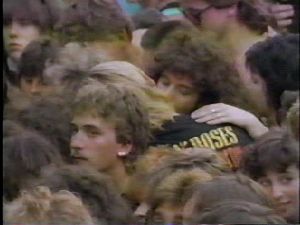 Quick cutting among the band members: Adler is all hair and arms, Izzy leans forward intensely, Slash gyrates and hammers on his guitar. It’s all very high energy, and it doesn’t matter that the band’s outfits don’t perfectly match from shot to shot (we appear to be seeing soundcheck and the show edited together). We learn that Axl’s white jacket has a big Guns N’ Roses logo on the back and that Adler, like many other members of the band, owns a leather vest. In New York City, Duff strolls down the sidewalk, turning to check out a girl. As the verse finishes, the director demonstrates his eye for rock-concert minutiae again, finding a guy in a GN’R shirt sucking face with his big-haired girlfriend in the middle of the crowd.
Quick cutting among the band members: Adler is all hair and arms, Izzy leans forward intensely, Slash gyrates and hammers on his guitar. It’s all very high energy, and it doesn’t matter that the band’s outfits don’t perfectly match from shot to shot (we appear to be seeing soundcheck and the show edited together). We learn that Axl’s white jacket has a big Guns N’ Roses logo on the back and that Adler, like many other members of the band, owns a leather vest. In New York City, Duff strolls down the sidewalk, turning to check out a girl. As the verse finishes, the director demonstrates his eye for rock-concert minutiae again, finding a guy in a GN’R shirt sucking face with his big-haired girlfriend in the middle of the crowd.
We hit the chorus. Axl struts on the lip of the stage. The fans pump their fists and throw rolls of toilet paper. (This was filmed on a tour where GN’R were the opening act for Aerosmith; I considered going to this very concert but decided not to because while it had been a two-band bill all across the country, for some reason the New York promoter shoehorned Deep Purple into the middle.) I haven’t mentioned it before, but “Paradise City” is an excellent song: snarling but sentimental, melodic but dirty, commercial but tough. The longest song on Appetite for Destruction, it was also the only one to employ a synth. I don’t think there’s been a time in the last two decades when I haven’t enjoyed hearing it.
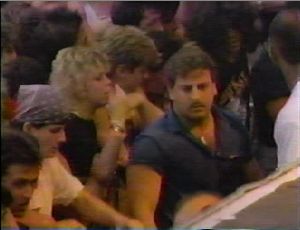 Adler, on a ferry, points to the Manhattan skyline (complete with World Trade Center). He is holding a can of Coke. Onstage, Axl keeps tucking his hair behind his ear. If you watch carefully, you can see some guy in the background jumping over the railing from the box seats, joining the general-admission scrum. Somebody throws a denim jacket on the stage. A fan tries to jump up onstage and gets pushed back down by a security guard. There’s a wonderful one-second clip of another security guard (mustache, open-necked polo shirt) watching the action, his eyes twitching nervously.
Adler, on a ferry, points to the Manhattan skyline (complete with World Trade Center). He is holding a can of Coke. Onstage, Axl keeps tucking his hair behind his ear. If you watch carefully, you can see some guy in the background jumping over the railing from the box seats, joining the general-admission scrum. Somebody throws a denim jacket on the stage. A fan tries to jump up onstage and gets pushed back down by a security guard. There’s a wonderful one-second clip of another security guard (mustache, open-necked polo shirt) watching the action, his eyes twitching nervously.
More rocking. Slash is wearing a T-shirt with what appears to be the Hard Rock Café logo on it, but actually reads “Hard Cock.” (I assume that slipped by MTV.) Slash spits on the stage. A camera at the back of the stage captures him walking over to an high-powered fan and letting it cool him down for just a moment. We hit the chorus and again get Duff, Izzy, and Axl all lined up.
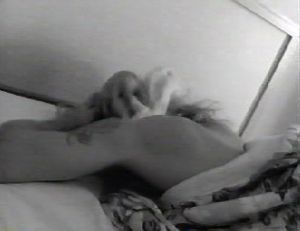 We continue to cut from color film of Giants Stadium to black-and-white offstage footage. In a hotel room, somebody wakes up a Gunner (Adler, I think), who responds by covering his head with pillows and blankets. Backstage, in a cement-block bathroom, Slash walks past Duff and with a smirk, flaps his T-shirt at him. Slash has a cigarette dangling from his lips–this band smoked a lot. Contrary to my thoughts on the Phil Collins video, MTV circa 1988 doesn’t seem to have had any prohibitions on cigarettes.
We continue to cut from color film of Giants Stadium to black-and-white offstage footage. In a hotel room, somebody wakes up a Gunner (Adler, I think), who responds by covering his head with pillows and blankets. Backstage, in a cement-block bathroom, Slash walks past Duff and with a smirk, flaps his T-shirt at him. Slash has a cigarette dangling from his lips–this band smoked a lot. Contrary to my thoughts on the Phil Collins video, MTV circa 1988 doesn’t seem to have had any prohibitions on cigarettes.
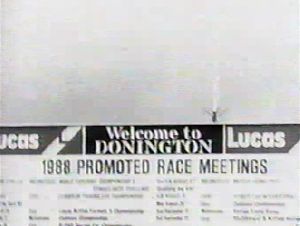 New locale: an airport, where the band walks over to a British Airways Concorde (now, like Giants Stadium, Manny’s, and the Twin Towers, consigned to history). After a color glimpse of Axl launching into the “so far away” bridge, we get an image of a sign that reads “Welcome to Donington.” It says some other things too, like “1988 Promoted Race Meetings,” but the videomakers are making sure you know where the Concorde took Guns N’ Roses: Castle Donington in England, for the annual Monsters of Rock festival.
New locale: an airport, where the band walks over to a British Airways Concorde (now, like Giants Stadium, Manny’s, and the Twin Towers, consigned to history). After a color glimpse of Axl launching into the “so far away” bridge, we get an image of a sign that reads “Welcome to Donington.” It says some other things too, like “1988 Promoted Race Meetings,” but the videomakers are making sure you know where the Concorde took Guns N’ Roses: Castle Donington in England, for the annual Monsters of Rock festival.
There are a lot of logos in this video that imply endorsements from the Gunners, mostly on T-shirts: I’ve mentioned Harley-Davidson and CBGBs, but we also see Rolling Stone on Slash, Aerosmith on Duff, the Cathouse on Axl, and Mrs. Jay’s Beer Garden on Adler. But name-checking Castle Donington is somewhat different: it’s the show where two fans were crushed to death in the mud during Guns N’ Roses’ set.
 Quick cuts: the band on a bus, British fans, bobbies in their rounded helmets, Axl looking cheerful, the offical Monsters of Rock sign for the “Guns N’ Roses Dressing Room” (precisely nailing down the date of this footage: Saturday, 20 August 1988). This video is long enough that we’ve now seen the band preparing to go onstage three different times.
Quick cuts: the band on a bus, British fans, bobbies in their rounded helmets, Axl looking cheerful, the offical Monsters of Rock sign for the “Guns N’ Roses Dressing Room” (precisely nailing down the date of this footage: Saturday, 20 August 1988). This video is long enough that we’ve now seen the band preparing to go onstage three different times.
“Captain America’s been torn apart / Now he’s a court jester with a broken heart,” Axl sings, in color at Giants Stadium. The format of the song is straightforward: the verses are about being imprisoned in a diseased society, while the chorus is about escaping to the paradise city “where the grass is green and the girls are pretty.” One doesn’t usually go to cities for the green grass, but I suppose that’s what makes this one paradise.
 Back to Donington. Axl shows off his backstage passes. He flips up the top one to display one underneath, which classifies him as “GUNS N’ ROSES / ARTISTES.” (“Access to stage is only up to and including Artistes set,” it reads underneath.) Axl gives a meaningful look straight into the camera which I always interpreted as “It’s amusing that they’re calling me an artiste, yes, but as it happens, I am one.” What I never noticed until now with the advantage of freeze-frame–and what I don’t remember anybody discussing at the time–was the top backstage pass: an “Access All Areas” pass emblazoned with the eagle logo of the SS (the elite Nazi troops), complete with swastika. Axl’s wearing the leather military cap again; some guy on Wikipedia claims it is a “World War II Nazi officer cap,” and indeed, it seems to be in the same style as Nazi caps, although it bears no logos. I think Axl was showing off the “Artistes” pass rather than the SS Eagle, but his mind is a strange and squirrelly place, and obviously he enjoyed having a swastika hang from his neck. I suspect he wasn’t a believer in the master race, but was pursuing cheap nihilistic thrills. This was the same impulse that led him to release a Charles Manson cover five years later. In brief, I’d peg him as an asshole more than a racist, although he’s probably both.
Back to Donington. Axl shows off his backstage passes. He flips up the top one to display one underneath, which classifies him as “GUNS N’ ROSES / ARTISTES.” (“Access to stage is only up to and including Artistes set,” it reads underneath.) Axl gives a meaningful look straight into the camera which I always interpreted as “It’s amusing that they’re calling me an artiste, yes, but as it happens, I am one.” What I never noticed until now with the advantage of freeze-frame–and what I don’t remember anybody discussing at the time–was the top backstage pass: an “Access All Areas” pass emblazoned with the eagle logo of the SS (the elite Nazi troops), complete with swastika. Axl’s wearing the leather military cap again; some guy on Wikipedia claims it is a “World War II Nazi officer cap,” and indeed, it seems to be in the same style as Nazi caps, although it bears no logos. I think Axl was showing off the “Artistes” pass rather than the SS Eagle, but his mind is a strange and squirrelly place, and obviously he enjoyed having a swastika hang from his neck. I suspect he wasn’t a believer in the master race, but was pursuing cheap nihilistic thrills. This was the same impulse that led him to release a Charles Manson cover five years later. In brief, I’d peg him as an asshole more than a racist, although he’s probably both.
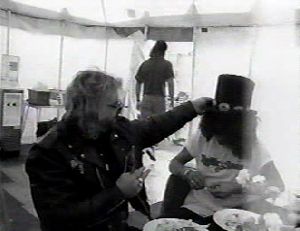 Quick cuts backstage at Donington: two Asian girls in shiny black raincoats, Izzy noodling on his guitar, a bearded guy in the catering tent putting Slash’s top hat back on his head. And then there’s a dramatic drumroll and the song, which has been loping along like a rocked-up campfire number for the past five minutes, abruptly switches into a double-time coda. Seven-minute hit singles weren’t any more common in 1988 than they are today, but this was a hard track to edit down–the way my local pop station (Z-100 in New York) did it was by chopping out this ending, which made them seem wimpy every time they played the song.
Quick cuts backstage at Donington: two Asian girls in shiny black raincoats, Izzy noodling on his guitar, a bearded guy in the catering tent putting Slash’s top hat back on his head. And then there’s a dramatic drumroll and the song, which has been loping along like a rocked-up campfire number for the past five minutes, abruptly switches into a double-time coda. Seven-minute hit singles weren’t any more common in 1988 than they are today, but this was a hard track to edit down–the way my local pop station (Z-100 in New York) did it was by chopping out this ending, which made them seem wimpy every time they played the song.
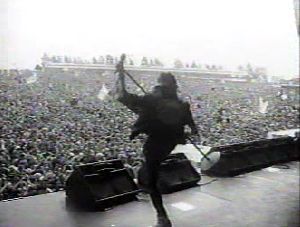 As Axl yowls “Hoooooooome,” the Gunners take the Donington stage and we see the crowd: over 100,000 fans, stretching out to the horizon. Holding the microphone stand, Axl does a high kick. The fans go nuts, moshing and pogoing. The crowd undulates like a sheet in a windstorm. It’s thrilling–and also sickening, when you realize that this hysteria is what killed two people. Because the band took such care to specify what show this footage came from, they want you to know that you are watching a snuff film.
As Axl yowls “Hoooooooome,” the Gunners take the Donington stage and we see the crowd: over 100,000 fans, stretching out to the horizon. Holding the microphone stand, Axl does a high kick. The fans go nuts, moshing and pogoing. The crowd undulates like a sheet in a windstorm. It’s thrilling–and also sickening, when you realize that this hysteria is what killed two people. Because the band took such care to specify what show this footage came from, they want you to know that you are watching a snuff film.
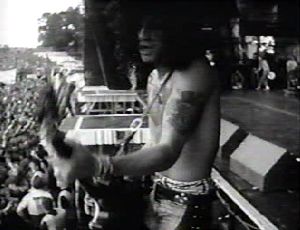 Apparently, Guns N’ Roses craved their own Altamont–and having gotten it, they did whatever they could to make it more mythic. In a 1988 Rolling Stone article, Axl told Rob Tannenbaum he had watched Gimme Shelter “probably a hundred times.” The band told Tannenbaum they stopped their show three times at Donington to calm the crowd down, but they also clearly enjoyed the audience response and didn’t think they were responsible for the deaths.
Apparently, Guns N’ Roses craved their own Altamont–and having gotten it, they did whatever they could to make it more mythic. In a 1988 Rolling Stone article, Axl told Rob Tannenbaum he had watched Gimme Shelter “probably a hundred times.” The band told Tannenbaum they stopped their show three times at Donington to calm the crowd down, but they also clearly enjoyed the audience response and didn’t think they were responsible for the deaths.
 The editing gets faster as we pound through the coda. We get a few flashes of color from Giants Stadium and some more backstage shots, including Izzy looking at a photo of Slash. Axl hops down the length of the stage, wielding the microphone stand like a machete. Everyone in Guns N’ Roses had charisma, but Axl Rose most of all. He’s wearing a backwards baseball cap over a bandana, and a Guns N’ Roses shirt so that you won’t mistake him for David Lee Roth. The song ends, and Axl rushes off the Donington stage. We don’t hear him speak, but apparently his final words to the throng were “Have a good fuckin’ day. And don’t kill yourselves.”
The editing gets faster as we pound through the coda. We get a few flashes of color from Giants Stadium and some more backstage shots, including Izzy looking at a photo of Slash. Axl hops down the length of the stage, wielding the microphone stand like a machete. Everyone in Guns N’ Roses had charisma, but Axl Rose most of all. He’s wearing a backwards baseball cap over a bandana, and a Guns N’ Roses shirt so that you won’t mistake him for David Lee Roth. The song ends, and Axl rushes off the Donington stage. We don’t hear him speak, but apparently his final words to the throng were “Have a good fuckin’ day. And don’t kill yourselves.”
“Paradise City” hit #5 on the American pop charts. You can watch the video here.
posted 3 February 2011 in 1988. 6 comments

